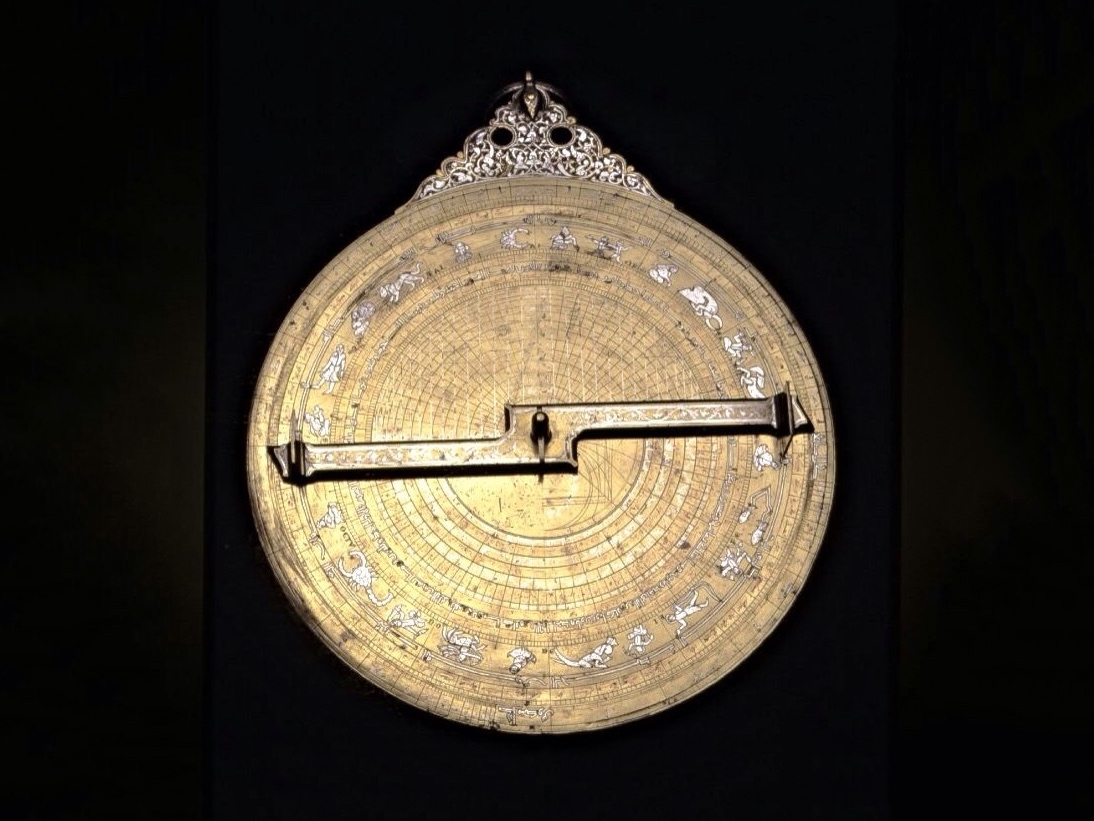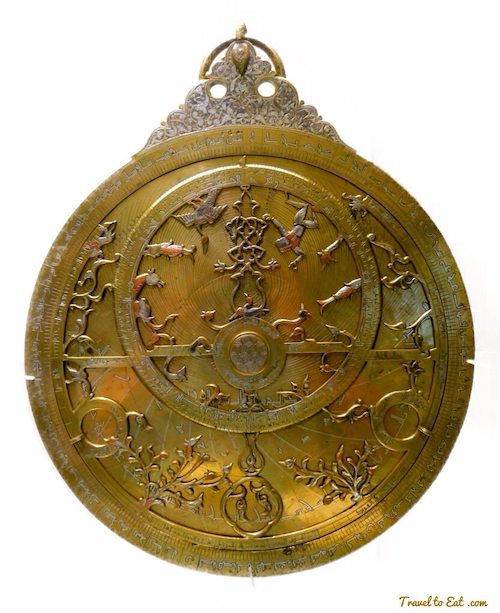
I recently saw an exhibit at the British Museum regarding the importance of timekeeping and physical direction for Muslims. Salat times refers to times when Muslims perform prayers (salat). The term is primarily used for the five daily prayers plus the Friday prayer. According to Muslim beliefs, the salat times were taught by Allah to Muhammad. Prayer times are standard for Muslims in the world, especially the fard prayer times. They depend on the condition of the Sun and geography. There are varying opinions regarding the exact salat times, the schools of Islamic thought differing in minor details. All schools agree that any given prayer cannot be performed before its stipulated time. The five prayers are Fajr (pre-dawn), Dhuhr (midday), Asr (afternoon), Maghrib (sunset) and Isha’a (night). Thus a keen interest was instilled in devout Muslims about the time and direction needed for prayers. The beautiful Arabic astrolabe shown above is made of brass inlaid with silver and copper by Abd al-Karim al-Misri from 1235-1236 CE. Abu Abdallah Muhammad ibn Ibrahim al-Fazari (died 796 or 806) is credited with the first astrolabe in the Islamic world in the 8th century. While some sources refer to him as an Arab, other sources state that he was a Persian. Al-Fazārī translated many scientific books into Arabic and Persian.
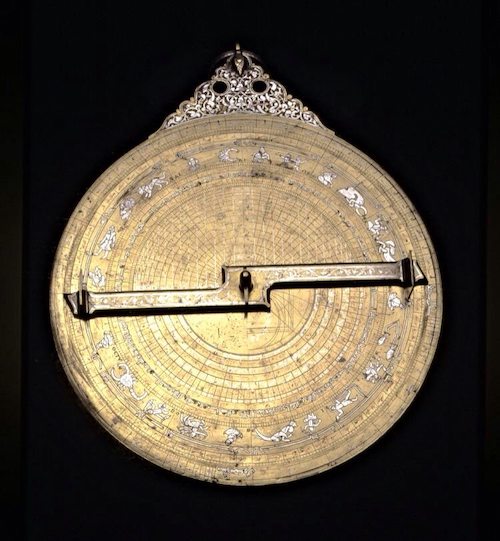
The astrolabe is an object probably invented by the Greeks in the 2nd century BC. Knowledge of it was transmitted to the Muslims through the translation of Hellenistic and Byzantine texts into Arabic. The translation of scientific texts was done in Baghdad in the early Abbasid era, and the earliest astrolabes and astrolabe treatises date to the 9th century. The astrolabe provides a two-dimensional map of the heavens and it served in particular to find the direction of Mecca which Muslims face when they pray, and was used to determine the times of the times of prayer which were astrologically defined. This extremely important example has figural designs representing the constellations on the front and back. It gives the name of the artist who made it ,”Abd al-Karim”, who is known through other signed astrolabes. This instrument is noted as an early example of a “royal” astrolabe, similar to one signed by the same maker in the Oxford MHS.
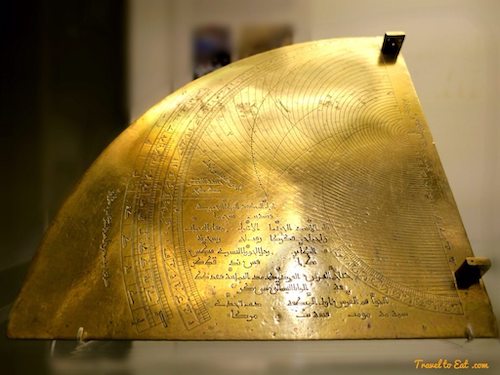
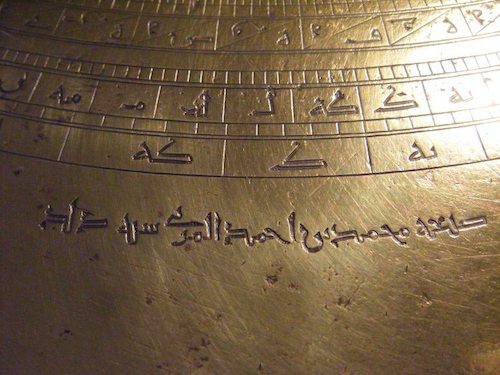
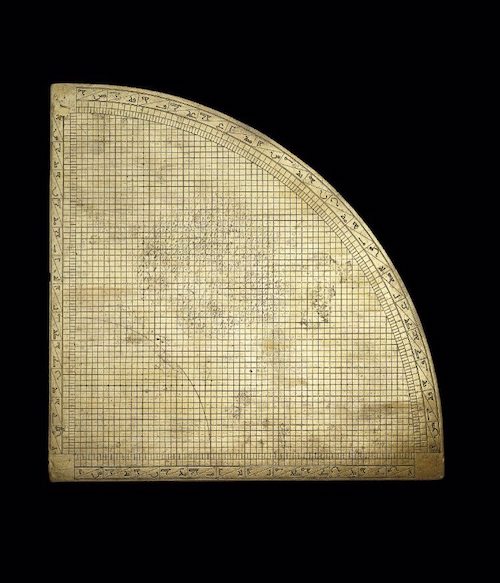
This brass astrolabic quadrant, a Quadrans Novus or astrolabe/almucantar quadrant, was made for latitude 33 degrees 30 minutes (i.e. Damascus) from 1333-1334 by Muhammad Bin Ahmad al-Mizzi. An inscription on the front says that the quadrant was made for the ‘muwaqqit’ (literally: the timekeeper) of the Great Umayyad Mosque of Damascus. The earliest known description of an astrolabe reduced to a quadrant with no moving parts was in 1288 by the Jewish man Jacob ben Mahir ibn Tibbon (1236-1304), more widely known by his Latin name of Prophatius Judaeus or Profeit Tibbon from Montpellier. Tibbon’s treatise was quickly improved by Peter Nightingale whose account received wide distribution. The instrument was quickly named the quadrans novus (new quadrant) to differentiate it from the traditional quadrant or quadrans vetus (old quadrant). The basic idea behind the idea of the quadrans novus is that the stereographic projection that defines the components of a planispheric astrolabe is just as valid if the astrolabe parts are folded into a single quadrant. The result is an instrument that can perform many of the functions of a standard astrolabe at much lower cost, but without the intuitive representation of the sky provided by the rotating rete. It is not clear how popular the astrolabe quadrant became as few examples survive. The arcs reproduce the ecliptic and horizons of a circular astrolabe folded over the East-West line and then folded again about the meridian. Additional arcs are provided to determine the unequal hours and to find the sines and cosines of angles. The astrolabe quadrant is equipped with with a thread (usually of silk) with one end attached at the north pole and a weight on the other end. A bead or pearl can be slid up and down the thread to mark positions on the face of the instrument. The thread can be moved to any position on the face of the quadrant to simulate the rotation of the astrolabe rete.
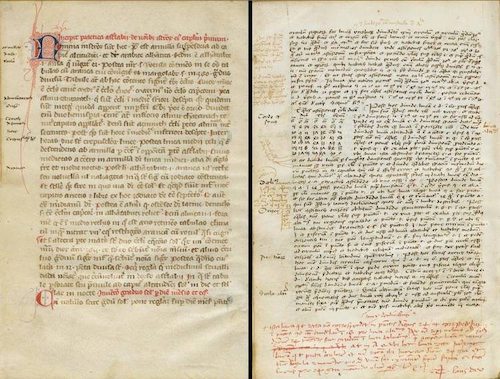
This is the book “Quadrans vetus”, a technical manual on the construction and use of the ‘old quadrant’, as distinct from the astrolabe-quadrant, or quadrans novus. The text was written in Montpellier, c.1250-80 (perhaps in 1276), and it is variously ascribed to Johannes Anglicus, John of Montpellier or to Robertus Anglicus. It gives a careful account of how to construct a quadrant, an instrument of Arabic origin which found its way into the West in the twelfth century, used in surveying and for measuring time from observations of the sun. Apparently Montpellier was a center of astrological scholarship. Acquired from Jones, his tutor, by George Parker, second Earl of Macclesfield (1697-1764); and from the library at Shirburn Castle (shelfmark I.2 in pencil). Sold at Sotheby’s in 2004.
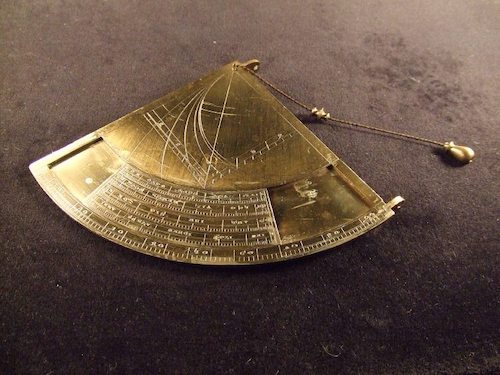
This undated and unsigned instrument is a rare example of a quadrans vetus with markings for unequal hours and a movable scale with months and zodiacal signs so that the quadrant can be used at a wide range of latitudes. The quadrant’s design is very similar to the instrument described in a manuscript by John of Montpellier written before 1350 which I discussed above. The Gothic letters and numerals of the original inscriptions make it likely that the quadrant was made in the 14th century. The letter forms resemble those found on a number of early English instruments. British Museum number 1972,0104.1.
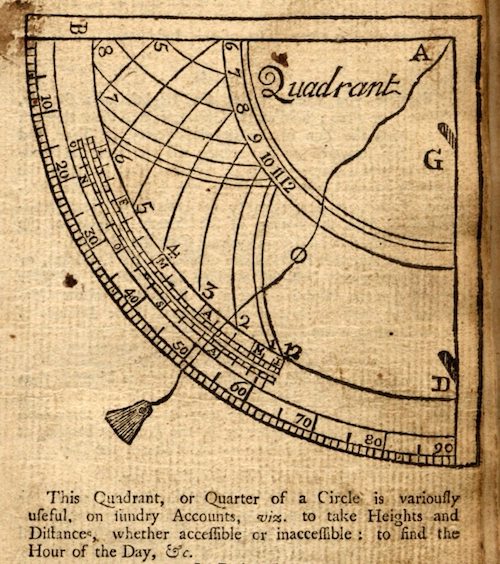
An anonymous manuscript on various forms of the universal horary quadrant (not fixed to a single latitude) in the Egyptian National Library in Cairo from the 9th century might have been by the celebrated ninth-century astronomer Abū Ja’far al-Khwārizmī, who also authored the earliest known treatises on the horary quadrant or quadrant vetus for a specific latitude and the sine quadrant. It predates the entire Latin quadrant vetus tradition. (See references). The figure above shows a horary quadrant for a latitude of about 51.5° as depicted in an instructional text of 1744: To find the Hour of the Day: Lay the thread just upon the Day of the Month, then hold it till you slip the small Bead or Pin-head [along the thread] to rest on one of the 12 o’Clock Lines; then let the Sun shine from the Sight G to the other at D, the Plummet hanging at liberty, the Bead will rest on the Hour of the Day.
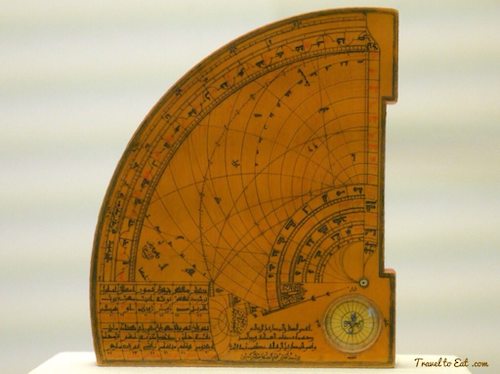
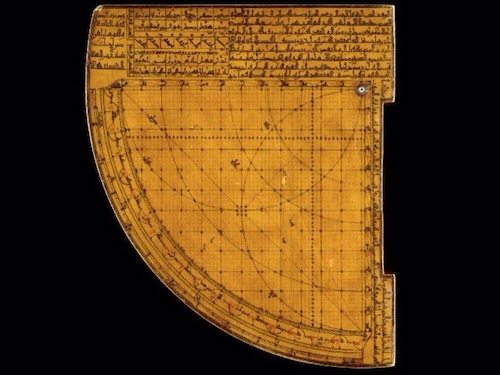
This belongs to a type of quadrant astrolabe which an official or merchant might have used in the Ottoman empire in the 18th and 19th centuries. In the small rectangular panel on the back there is a perpetual calendar calculated for the Islamic lunar year. Its earliest date is 1891 CE (AH 1308) and it has the idiosyncratically Turkish feature of being calculated for cycles of eight years. Also on this side, there is a second perpetual calendar calculated for the Turkish solar year. The Turks were unique within Islam in adopting a solar year for all their financial transactions while still using the lunar calendar for religious festivals. The name of this financial year was ‘maliye’. ‘Maliye’ calendars were also slightly odd in the fact that they marked leap years one year early and therefore according to these calendars this quadrant was made in AH 1307 whereas according to the Islamic calendar it was made in AH 1308. On the side with the compass there is a correspondence table between four different calendars: the Islamic, the Turkish ‘maliye’ year, the Christian Coptic and a French Julian, rendered into Ottoman Turkish transcriptions. Each of these is laid out month by month relative to the Arabic names of the months. If one takes the first Arabic month of Nissan, according to the ‘maliye’ calendar, the month starts five days after Nissan begins whereas according to the French calendar the first day of mars (March) starts twelve days after Nissan, and by calculating astronomically the first point of the sign of Aries begins 23 days after the beginning of Nissan.
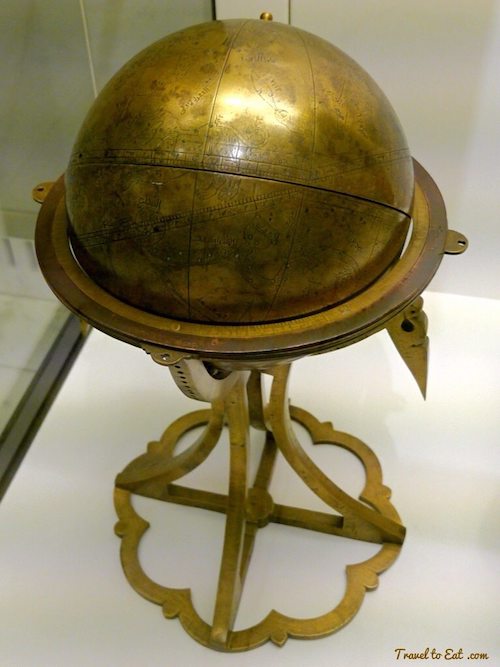
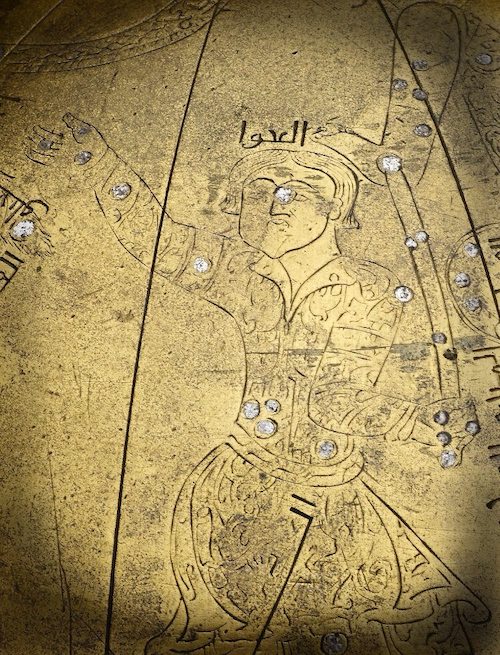
Celestial globes were used by Arabic astronomers primarily for solving problems in celestial astronomy. Today, 126 such instruments remain worldwide, the oldest from the 11th century. The altitude of the sun, or the Right Ascension and Declination of stars could be calculated with these by inputting the location of the observer on the meridian ring of the globe. This example from 1271 in the British Museum is a real beauty.
Science was considered the ultimate scholarly pursuit in the Islamic world, and it was strongly supported by the nobility. Most scientists worked in the courts of regional leaders, and were financially rewarded for their achievements. In 830, the Khalifah, al-Ma’muun (813-833), founded Bayt-al-Hikman, the “House of Wisdom”, as a central gathering place for scholars to translate texts from Greek and Persian into Arabic. These texts formed the basis of Islamic scientific knowledge and in 829 he established the first permanent astronomical observatory in the world.
- One of the greatest Islamic astronomers was al-Khwarizmi (Abu Ja’far Muhammad ibn Musa Al-Khwarizmi), who lived in the 9th century and was the inventor of algebra. The first major Muslim work of astronomy was Zij al-Sindh by al-Khwarizmi in 830. He constructed a table of the latitudes and longitudes of 2,402 cities and landmarks, forming the basis of an early world map.
- Around the same time, the Persian Al-Farghani wrote Elements of Astronomy (Kitab fi al-Harakat al-Samawiya Jawami Ilm wa al-Nujum), a book based on the Ptolemaic astronomy. It is said that Dante got his astronomical knowledge from al-Farghani’s books.
- Around the end of the ninth century, the dominant figure is the Arabic astronomer Al-Battani who observed the sky from Syria and took measurements remarkably accurate for the time. He determined the length of the solar year, the value of the precession of the equinoxes and the obliquity of the ecliptic. He also established a catalog of 489 stars.
- In the late 10th century, a huge observatory was built near Tehran, Iran by the astronomer al-Khujandi. In Islamic astronomy, Khujandi worked under the patronage of the Buwayhid Amirs at the observatory near Ray, Iran, where he is known to have constructed the first huge mural sextant in 994 AD, intended to determine the Earth’s axial tilt (“obliquity of the ecliptic”) to high precision and was the first astronomer to be capable of measuring to an accuracy of arcseconds.
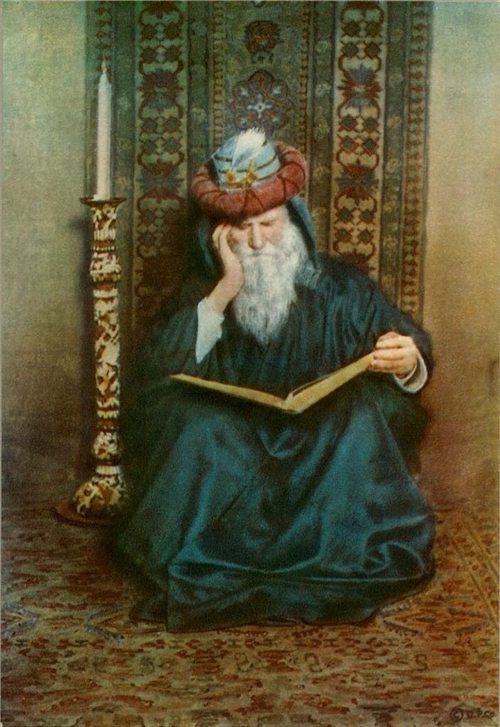
In the eleventh century the Persian Omar Khayyam, today best known for his poetry, was also interested in various subjects, particularly algebra and astronomy. I have to name the book, The Rubáiyát of Omar Khayyám, one of my favorites, is the title that Edward FitzGerald gave to his translation of a selection of poems, originally written in Persian and of which there are about a thousand, attributed to Omar Khayyám (1048–1131). He compiled many astronomical tables and performed a reformation of the calendar which was more accurate than the Julian and came close to the Gregorian. An amazing feat was his calculation of the year to be 365.24219858156 days long, which is accurate to the 6th decimal place!
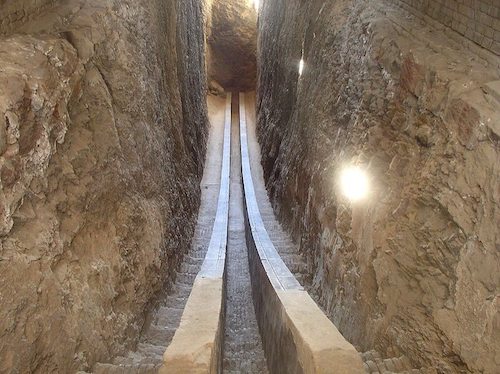
An observatory was built by Ulugh Beg in Samarkand, in the Timurid Empire (15th century), present day Uzbekistan Ulugh Beg (1394-1449) in which was constructed the “Fakhri Sextant” that had a radius of 40 meters. Seen in the image above, the arc was finely constructed with a staircase on either side to provide access for the assistants who performed the measurements on star positions.
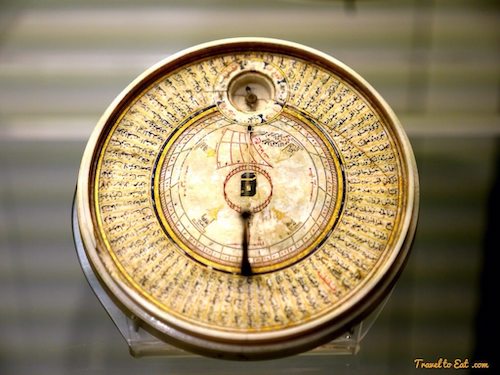
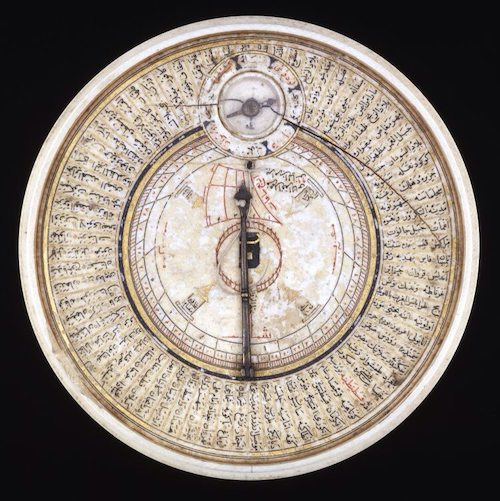
A Qibla compass or qiblah compass (sometimes also called qibla/qiblah indicator) is a modified compass used by Muslims to indicate the direction to face to perform ritual prayers. In Islam, this direction is called qibla, and points towards the city of Mecca and specifically to the Ka’abah. While the compass, like any other compass, points north, the direction of prayer is indicated by marks on the perimeter of the dial, corresponding to different cities. To determine the proper direction, one has to know with some precision both the longitude and latitude of one’s own location and those of Mecca, the city toward which one must face. The outermost circle along the rim is divided into 72 sectors that give the names of cities and regions in the Islamic World, all written in black with the exception of Qustantinīa (Istanbul) which is written in red. Each sector contains at least two, often more names, separated from each other by gold dots. Presumably, one finds the city one wants and determines the direction of Mecca from the markings around the compass.
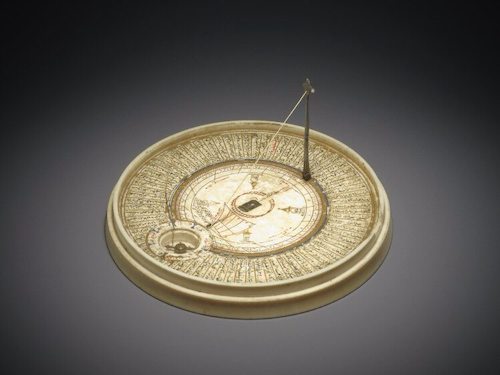
The inside of the main box is laid out in various concentric circles, separated from each other by gold and blue. In the center is a schematic depiction of the Ka’ba in black and gold, surrounded by a red fence. A line drawn in gold from north to south intersecting with the fence and the Ka’ba is labelled in black khatṭ̣ ̣al-zawāl (meridian line). The red sail-shaped feature between the Ka’ba and a small compass in the upper part of the instrument is a sundial that enables the user to find the time of the ‘asr prayer in the afternoon. It is labelled 1 to 4 in Arabic numerals (١, ٢, ٣ and ٤) and is laid out in so-called ‘unequal hours’ (that is the length of daylight between sunrise and sunset divided into twelve parts whose length changes over the course of the year). To the right of the first hour curve is a red inscription arba’a sā’āt (= four hours, i.e. before the ‘asr prayer). You can also use the sundial inscribed on the concentric circles.
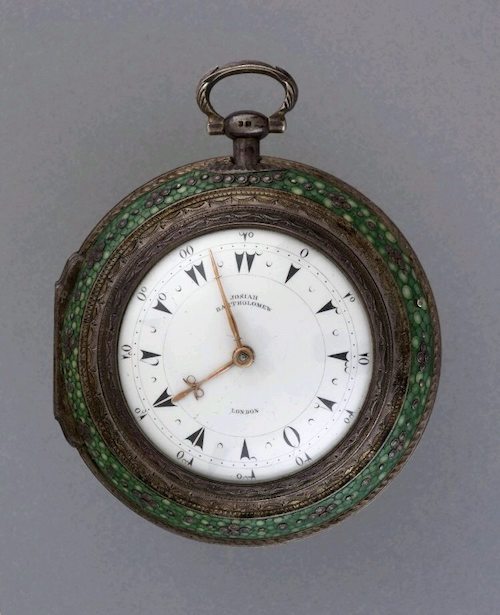
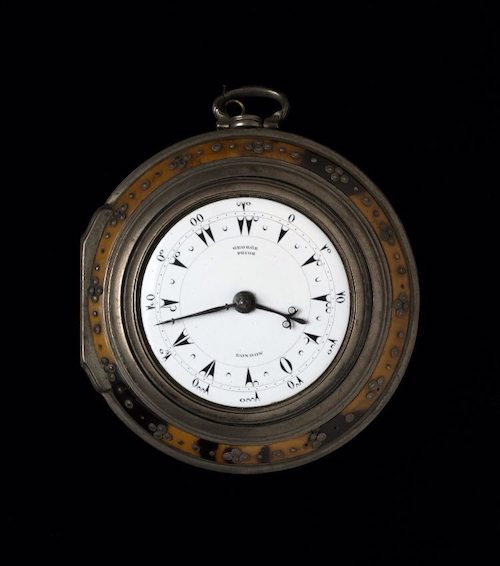
These are two silver triple cased verge watches for the Turkish market around the end of the 18th century. The white enamel dials show very stylized Arabic numbers with Turkish hours and minutes. I was personally surprised to find the numbers were not represented as European numbers. The Hindu-Arabic numerals were invented in India between the first and fourth century and were thus called “Hindu numerals” by the Persian mathematician Khowarizmi. They were later called “Arabic” numerals by Europeans, because they were introduced in the West by Arabized Berbers of North Africa.
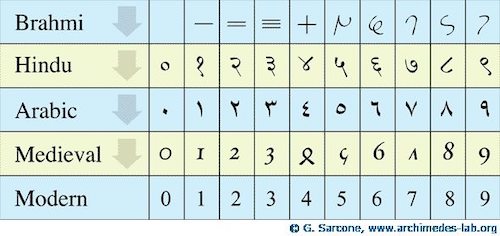
Today’s numbers, also called Hindu-Arabic numbers, are a combination of just 10 symbols or digits: 1, 2, 3, 4, 5, 6, 7, 8, 9, and 0. These digits were introduced in Europe within the XII century by Leonardo Pisano (aka Fibonacci), an Italian mathematician. L. Pisano was educated in North Africa, where he learned and later carried to Italy the now popular Hindu-Arabic numerals.
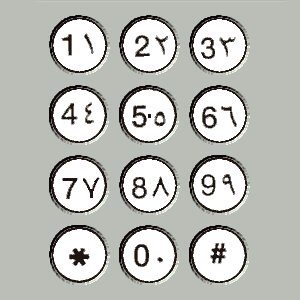
Even today Arabic numbers differ from western numbers. Above is a telephone keypad with Arabic numbers.
During the period when Western civilization was experiencing the dark ages, between 700-1400 CE an Islamic empire stretched from Central Asia to southern Europe. Scholarly learning was highly prized by the people, and they contributed greatly to science and mathematics. Many classical Greek and Roman works were translated into Arabic, and scientists expanded on the ideas. A significant number of stars in the sky, such as Aldebaran and Altair, and astronomical terms such as alhidade, azimuth, and almucantar, are still referred to by their Arabic names. A large corpus of literature from Islamic astronomy remains today, numbering approximately 10,000 manuscripts scattered throughout the world. Perhaps the most fascinating aspect of Islamic astronomy is the fact that it built on the sciences of two great cultures, the Greeks and the Indians. Blending and expanding these offen different ideas led to a new science which later profoundly influenced Western scientific exploration beginning in the Renaissance. I hope you have enjoyed this long but I hope interesting introduction to Arabian astronomy.[mappress mapid=”112″]
References:
Quadrent Vetus: http://adsabs.harvard.edu/full/2002JHA….33..237K
Horary Quadrent: http://www.raco.cat/index.php/Suhayl/article/download/199578/266898
Manuscript: http://www.artfact.com/auction-lot/quadrans-vetus,-and-other-texts-on-the-constructi-584-c-3lan5tbzm4
Islamic Astronomy: http://www.siasat.pk/forum/showthread.php?102927-Islamic-Astronomy-Astronomical-instruments
For further information on (astrolabic) quadrants in the Islamic World see David King, Article ‘Rub” in: The encyclopedia of Islam, vol. 8 (1995), pp. 574-75.
Starteach Astronomy: http://www.starteachastronomy.com/arab.html

